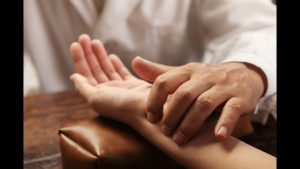NADI PARIKSHAN|

Nadi Pariksha is the ancient ayurvedic technique of diagnosis through the pulse. It can accurately diagnose physical, mental and emotional imbalances as well as diseases. It is a non- invasive science that enables us to reach the root cause of health issues and not just address the symptoms. Pulse diagnosis was initially identified in the books of Sharangdhar Samhita in the 13th century highlighting the correlation between Nadi and Tridosha. Later, in the 16th century it was again mentioned in ‘Bhavprakash’ scripted by Shri Bhav Mishrji.However, Nadi Pariksha gained its significance during the 17th century in Yogratnakar through 48 shlokas, detailing the science of Nadi. The scripture highlights details such as the appropriate time for Nadi Pariksha, rules for the Vaidya or Ayurvedic physician as well as the patient and also the rules to be followed before and after Nadi Pariksha. Indians are born and brought up with Ayurveda since birth. Unfortunately we do not understand it but we definitely know about Vata, Pitta and Kapha. Ayurveda has introduced and explained eight fold examinations. Asthavidha Pariksha (eight fold examination) in Ayurveda is one of the important examinations to find the various causes behind the diseases. It consists of eight factors Nadi (Pulse), Mootra (Urine), Mala (Stool), Jihwa (Tongue), Sabdam (Sound/ Voice), Sparsham (Touch), Druk (Eyes & Vision), Akriti (General body build). Nadi Pariksha plays very important role in diagnosis of the disease.
METHOD OF EXAMINING NADI –
According to Ayurveda, the presence of disease in our system indicates an imbalance in our doshas and bringing our system back into balance is the key to the cure & with the help of Nadi Pariksha & Ayurveda doctor can detect the imbalance in the body & prescribe an effective treatment. The hand of the patient should be free and slightly flexed at the forearm, so that the left hand of the physician, the 3 fingers of the right hand, namely the index finger, the middle finger and the ring finger of the physician gently touches the skin over the radial artery. The index finger is comfortably placed nearest the thumb and the other two fingers are placed next to it (the thumb should not be extended too far nor too much fixed).
BEST TIME FOR PULSE EXAMINATION –
It is clearly mentioned by all the rishis and vaidyas that the pulsation of pulse varies from time to time and day to day. Kapha pulse is predominant in morning time, pitta dosha is predominant during mid day and the vata pulse can be observed in late afternoon and evening. For precise diagnosis, it is recommended that the diagnosis be done on an empty stomach, early in the morning or three hours after food. The reason behind this principle is because, after the food metabolism process begins, the diagnosis process gets distorted. But in emergency conditions nadi parikshan can be done anytime.
To More Watch Our YouTube Video :- https://youtu.be/8S843o2Emdg
#nadiparikshan #ayurveda #jyovis #treatment #diagnosis
– For Doctor Consultation :- http://bit.ly/2tomCT6
– Go Through All The Products :- www.jyovis.com/store
– Online Learn & Earn Courses :- www.jyovis.com/courses
– Best Ayurvedic Products :- http://bit.ly/36ntvmA
– Top Cosmetic & Beauty Products :- http://bit.ly/2F99OCW
– Active Forever 21 Days Online Program :- https://www.jyovis.com/product/active…
